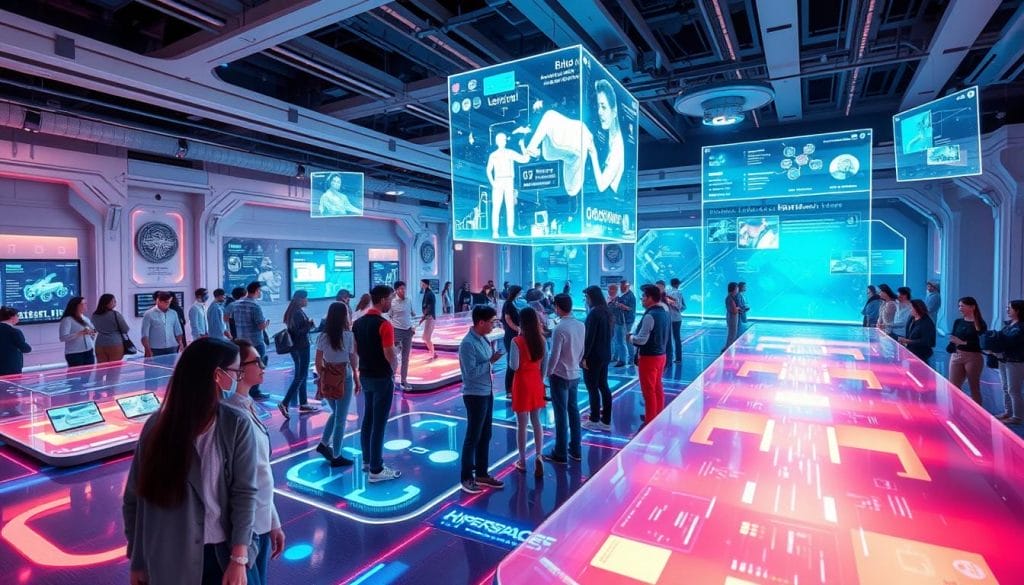Artificial intelligence (AI) is changing virtual learning spaces fast. It makes it possible to create endless, interactive places for learning together. With tools like generative AI, we can build real-looking 3D worlds. This opens up huge possibilities for learning in new ways.
The Holodeck app uses AI to let users make their own virtual spaces. It draws from a huge library of objects to make learning scenarios that feel real. This tech is not just for fun or training robots. It’s also great for school, where students can dive into learning that’s made just for them.
In the Metaverse, AI makes learning better by creating personalized avatars and changing environments. It also makes new content on the fly. This way of learning in virtual worlds is a game-changer. It lets students learn and explore in ways that old classrooms can’t.
Key Takeaways
- AI is changing virtual learning spaces, making them endless and interactive for learning together.
- Tools like the Holodeck use AI to build real-looking 3D worlds for education, fun, and training.
- In the Metaverse, AI makes learning better with personalized avatars and changing environments.
- AI in virtual learning spaces can make learning more personal and engaging.
- Using AI for virtual learning can open up new ways for students to learn and grow.
Introduction to AI in Virtual Learning Environments

AI-powered virtual classrooms and interactive 3D learning platforms have changed education. They bring new ways to learn. Artificial Intelligence (AI) makes learning online better, changing how students and teachers interact.
What is AI in Education?
AI in education means using AI to make learning better and more personal. It uses smart algorithms to help with learning and solving problems. This helps teachers create learning spaces that fit each student’s needs.
The Rise of Virtual Learning Spaces
Virtual learning spaces are online places where students can learn together. They use virtual reality, augmented reality, and social media for better learning. More people want to learn online, making these spaces more popular.
| AI-Powered Virtual Learning Solutions | Key Features |
|---|---|
| Coursera | Uses AI to suggest courses based on what you’ve learned before, making learning personal. |
| Knewton | Offers tutoring that changes based on how well you’re doing, helping where you need it most. |
| Gradescope | Grades your work with AI, giving you detailed feedback quickly and fairly. |
| Edmodo | Recommends videos and activities based on what you’ve learned, helping you learn more. |
| MAP Growth by NWEA | Adapts tests to match your skill level, making assessments more personal. |
| Duolingo | Uses AI to help with language learning, giving feedback on your pronunciation and grammar. |
These examples show how AI is changing online learning. It makes learning more personal, engaging, and efficient for students.
Benefits of Using AI in Collaborative Learning

Artificial Intelligence (AI) is changing how we learn together. It makes learning more engaging, personal, and immediate. With AI, teachers can build collaborative virtual reality spaces and AI-driven collaborative learning simulations. These tools make learning fun and effective.
Enhancing Engagement and Motivation
AI creates dynamic learning environments that keep students interested. These spaces change based on what each learner likes. This makes learning feel more like an adventure.
Personalization of Learning Experiences
AI helps make learning fit each student’s needs. It adjusts the content and feedback to match how each learner learns best. This way, learning is always relevant and challenging.
Facilitating Real-Time Feedback
AI gives learners feedback right away. This helps them see where they need to improve. It also helps teachers understand how to better help their students.
AI makes learning more engaging, personal, and effective. It helps students succeed in today’s digital world.
The Technology Behind AI-Driven Virtual Spaces
At the heart of AI-generated educational landscapes and virtual learning metaverses are powerful algorithms. These algorithms are the backbone of AI systems. They enable these virtual spaces to learn from data and improve over time. This makes the experiences more realistic and engaging for users.
Machine Learning Algorithms
Machine learning algorithms are trained on vast datasets. This allows AI systems to recognize patterns, make predictions, and create content tailored to users. They add detailed textures to landscapes, create realistic weather, and simulate complex ecosystems in virtual reality. This enhances the environmental realism.
Natural Language Processing Applications
Natural Language Processing (NLP) applications are key in virtual environments. NLP technology lets AI systems understand and respond to user requests in everyday language. For example, the Holodeck application uses NLP to understand user commands and create virtual spaces on the fly.
Together, these AI technologies create immersive and interactive virtual learning environments. They adapt to the needs and preferences of individual users. This leads to a more personalized and enriching educational experience.
“AI integration in 3D modeling enables the creation of lifelike objects and characters with detailed and anatomically correct features, contributing to a more immersive VR experience.”
Building Infinite Virtual Spaces
In the world of AI-powered virtual classrooms and infinite digital learning worlds, success depends on strong infrastructure and careful design. Creating these vast virtual spaces needs a deep understanding of the technologies behind them.
Infrastructure Requirements
To power infinite digital learning worlds, a solid technical base is essential. This includes fast servers, smooth networking, and expandable storage. Cloud computing and edge technologies help make these spaces available worldwide. This allows for global collaboration and sharing of knowledge.
Design Considerations
The design of AI-powered virtual classrooms is also key. Using procedural generation and machine learning, diverse and changing virtual worlds can be made. These worlds can grow and change based on what learners need, encouraging exploration and discovery.
Adding features like customizable avatars and virtual whiteboards helps learners and teachers work together better. Natural language processing and sentiment analysis make the experience even better. They allow for quick feedback and learning plans tailored to each person.
Creating these infinite digital learning worlds opens up new possibilities in education and training. By combining the latest technology with creative design, endless learning opportunities become a reality.
Case Studies of AI in Action
AI technology is becoming more common in schools. It helps teachers make learning better. Many examples show how AI works well in different schools.
Notable Educational Institutions Utilizing AI
Business schools lead in using AI and new tech. For example, ESSEC Business School in France has an AI avatar named eProf Cavarretta. It helps students anytime they need it.
INSEAD Business School in France has over 20 VR experiences. More than 40 teachers use XR in their classes. This makes learning more real.
ESMT Berlin uses VR to improve teamwork and thinking. They also add AI to their programs to help with decisions. NEOMA Business School in France even has a virtual campus. They use AI to make learning personal for students.
Successful Implementations
AI is not just for business schools. mRelief made an AI chatbot for SNAP food help in the US. It helps millions of people.
Alaska Airlines is working on an AI search feature. It will make booking flights easier for customers. Google Cloud customers use AI for many things, like customer service and data analysis.
Best Buy is launching an AI assistant to help with product issues. They also want to use AI to help their employees better serve customers.
These examples show how AI can change education and business. It makes learning more fun and personal.
Challenges in Implementing AI in Learning
The education sector is exploring the use of AI to create virtual spaces for learning. But, it faces many challenges. These include technical issues and resistance from educators.
Technical Limitations
AI needs strong infrastructure to work well in learning settings. This includes fast computers, lots of storage, and good networks. It also needs to work smoothly with current educational systems.
Resistance to Change Among Educators
Introducing AI in classrooms is a big change for many teachers. They might worry about how it will affect their teaching. To help, they need training and to see how AI can improve learning.
Keeping student data safe is also a big challenge. AI systems handle personal info, so strong security is key. This protects against data theft and unauthorized access.
To solve these problems, we need to mix tech with understanding of teacher and student needs. With teamwork and support, we can make AI a powerful tool for learning.
| Challenges | Potential Solutions |
|---|---|
| Technical Limitations | Invest in robust infrastructure, ensure seamless integration with existing systems |
| Resistance to Change Among Educators | Provide extensive training, support, and show AI’s benefits in learning |
| Data Privacy and Security Concerns | Implement strong data protection and follow legal guidelines |
User Experience in AI Virtual Learning
The use of immersive educational simulations and interactive 3D learning platforms is growing fast. The importance of user experience in AI-driven virtual learning is huge. Good design helps learners move easily through these virtual spaces. This makes learning more fun and effective.
AI can change how we learn online. It can make learning fit each student’s needs and style. Tools like language translation and adaptive interfaces help everyone learn together.
Intuitive Design for Users
Creating easy-to-use virtual learning spaces is key. AI-driven interfaces should be simple to navigate and look good. AI helps make these spaces better by learning what learners like.
Enhancing Accessibility and Inclusivity
Virtual learning should be for everyone. AI helps by making learning personal. Features like adaptive interfaces and language translation help learners from all backgrounds.
AI can make learning online better by focusing on user experience. With good design and inclusive features, virtual learning can be fun and open to all.
“AI-driven virtual learning environments have the power to change education. They make learning more engaging, personal, and open to everyone.”
Future Trends in AI-Driven Collaborative Learning
The world of education is changing fast, thanks to artificial intelligence (AI). AI is making virtual learning environments better. These new tools help make learning more engaging, personalized, and give instant feedback.
Predictions for Educational Technology
Soon, we’ll see even better virtual learning spaces. These will be powered by advanced AI. They will create stories and interactions that feel real. This will change how we make learning materials, making it faster and more efficient.
The Growing Importance of Data Analytics
Data analytics in education is becoming more important. AI will help make training better by using data on how students learn. This will help predict what students need to learn next and fill any gaps in their education.
The Learning and Development (L&D) market is growing fast, reaching over $350 billion. AI will play a big role in this growth. It will help create learning paths that change based on how each student is doing, making learning more effective.
| Key Trends | Impact on Collaborative Learning |
|---|---|
| Immersive Simulations and Experiential Learning | AI-powered virtual and augmented reality environments will provide engaging, hands-on learning experiences, helping students develop critical soft skills like problem-solving and teamwork. |
| Personalized Learning Pathways | AI algorithms will continuously refine and update training content based on learner interactions and feedback, delivering personalized learning experiences tailored to individual needs and preferences. |
| Hybrid Learning Models | The future of collaborative learning will likely involve a blend of online and in-person training, leveraging AI-driven technology to create engaging and effective learning environments. |
AI is key to making learning better in the future. It will help create more immersive, personalized, and data-driven learning experiences. By using AI, schools can prepare students for the 21st century.
Collaborating Across Borders with AI
In today’s world, we’re seeing a big change in how we learn and work together. AI is making it easier for people from different places to work together. It’s helping students from all over to share ideas and learn from each other.
Global Learning Communities
AI is creating special virtual spaces for learning. Students from everywhere can talk, share ideas, and learn from each other. This way, they can overcome the challenges of different languages and cultures.
Bridging Cultural Divides
AI is helping us understand and respect each other’s cultures. It lets students see things from different viewpoints. This way, they can learn without being held back by stereotypes or cultural differences.
As we become more connected, AI and virtual reality are changing education. They’re opening doors for students to learn and grow together, no matter where they are from.
“The future of education lies in the seamless integration of AI and virtual spaces, empowering learners to transcend borders and unlock the richness of global collaboration.”
Ethical Considerations and AI
As AI grows in education, we must think about ethics. Data privacy is key, as AI collects personal info like grades and behavior. This info is sensitive and must be protected.
It’s also important to make sure AI is fair and equal. Biased AI can hurt students, making things worse for those who are already behind. This can make learning unfair for many.
Data Privacy Concerns
Student data can be stolen, leading to big problems like identity theft. If we don’t tell students how their data is used, trust can break down. This raises questions about who owns and uses our data.
Ensuring Fairness and Equity
AI in education must respect all cultures. It’s also important to know who is making decisions with AI. Mistakes or unfair choices can harm students a lot.
Fixing these issues is key to using AI right in education. By focusing on privacy, fairness, and equality, we can make learning better for everyone. This way, AI can help make education more inclusive and powerful.
| Ethical Concern | Potential Impact | Mitigation Strategies |
|---|---|---|
| Data Privacy | Privacy breaches, identity theft, lack of trust | Transparent data collection policies, robust security measures, user consent protocols |
| Algorithmic Bias | Reinforcement of stereotypes, unequal treatment of students | Diverse data sets, bias testing, regular audits, inclusive design |
| Accountability | Unclear responsibility for AI-driven decisions, adverse impacts on students | Clearly defined policies, stakeholder engagement, oversight and governance |
| Equity in Access | Widening of educational disparities, limited opportunities for underprivileged students | Affordable and inclusive AI-powered tools, targeted outreach, digital literacy initiatives |
“Addressing ethical considerations is essential for the responsible development and implementation of AI in metaverse learning environments.”
Conclusion
AI is changing education in big ways. It lets us create endless virtual spaces for learning together. These spaces make learning personal and fun.
AI is getting better all the time. It will soon be a key part of how we teach and learn.
AI tools are making old ways of learning better. They offer lessons just for you, feedback right away, and content that changes as you learn. This helps teachers meet each student’s needs better.
AI uses smart tech to understand and help students. This makes sure everyone gets a fair chance to learn. It’s a big step towards making education fair for all.
The Transformative Power of AI in Education
AI is making learning in virtual spaces exciting and new. It brings students together from all over the world. This helps us learn from each other and work together.
AI and virtual reality are changing education fast. We’re on the edge of a new era in learning. It’s full of possibilities for exploring and discovering new things.
FAQ
Q: What is AI in Education?
A: AI in education uses artificial intelligence to make learning better. It includes machine learning for tasks like learning and solving problems.
Q: What are Virtual Learning Spaces?
A: Virtual learning spaces are online places where people can learn together. They use virtual reality, augmented reality, and social media for a better learning experience.
Q: How does AI enhance collaborative learning?
A: AI makes learning more personal by tailoring content to each learner. It uses avatars and environments that change based on how users interact.
Q: What technologies power AI-driven virtual spaces?
A: Machine learning, Natural Language Processing, and procedural generation are key. They make interactions feel more natural and create vast virtual worlds.
Q: What are the infrastructure and design considerations for building infinite virtual spaces?
A: Building these spaces needs strong servers for vast environments. Design must focus on scalable systems that change with user actions, using machine learning.
Q: What are some successful implementations of AI in education?
A: AI has been used for personalized learning, virtual tutors, and immersive environments. These have improved student engagement and learning outcomes.
Q: What are the challenges in implementing AI in learning environments?
A: Challenges include technical issues, educator resistance, and data privacy. Overcoming these needs a balance between tech and addressing concerns.
Q: How does user experience play a role in AI virtual learning environments?
A: Good design, accessibility, and inclusivity are key. AI makes these better by personalizing learning to fit individual needs.
Q: What are the future trends in AI-driven collaborative learning?
A: Future trends include better virtual environments and more personalized learning. Advanced AI will create dynamic stories and interactions. Data analytics will track student progress better.
Q: How does AI enable collaboration across geographical and cultural boundaries?
A: AI lets students from around the world learn together. Technologies like real-time translation help bridge cultural gaps.
Q: What are the ethical considerations around the use of AI in educational virtual spaces?
A: Ethical concerns include data privacy, fairness, and equity. AI must be inclusive and respectful of all cultures for responsible use.





